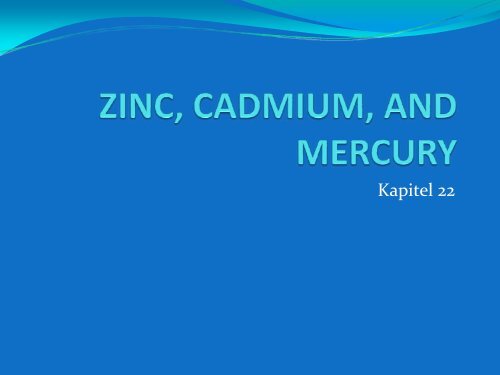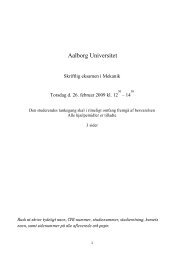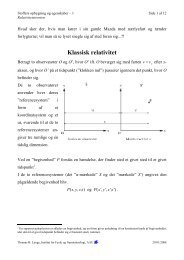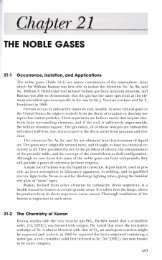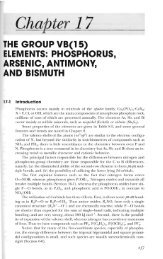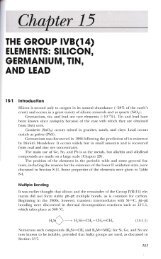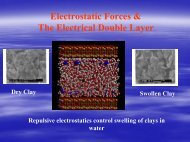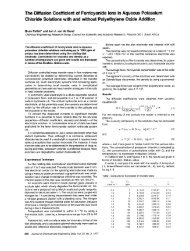Create successful ePaper yourself
Turn your PDF publications into a flip-book with our unique Google optimized e-Paper software.
Kapitel 22
<strong>ZINC</strong>, <strong>CADMIUM</strong>, <strong>AND</strong> <strong>MERCURY</strong><br />
• Now that we went through the main group elements,<br />
• We have reached the part of the periodic system where<br />
we look at some transition metal elements,<br />
• Or also called d‐block elements.<br />
• They are located in between the main block elements<br />
and their occurrence is due to the filling of the (n‐1)d<br />
orbitals.<br />
• The group IIB elements Zn,Cd,Hg are also called the<br />
transition elements
<strong>ZINC</strong>, <strong>CADMIUM</strong>, <strong>AND</strong> <strong>MERCURY</strong><br />
• Their characteristic is that either the neutral atom<br />
• Or one of its ions has an incomplete set of d‐electrons.<br />
• The elements Zn,Cd,and Hg have unique properties.<br />
• They resemble alkaline earth metals,<br />
• No Oxidation state higher then +2<br />
• Difference Polarizable nd 10 shell instead of noble gas<br />
shell.
<strong>ZINC</strong>, <strong>CADMIUM</strong>, <strong>AND</strong> <strong>MERCURY</strong><br />
Physico‐chemical properties of the elements are:<br />
Element<br />
El.<br />
configuration<br />
Mp ( 0 C)<br />
Ionic<br />
Radius (Å)<br />
E 0 (V)<br />
ΔH<br />
(kJ/mol)<br />
Zn [Ar] 3d 10 4s 2 420 0.88 ‐0.76 2632<br />
Cd [Kr] 4d 10 5s 2 320 0.92 ‐0.40 2492<br />
Hg [Xe]4f 14 5d 10 6s 2 ‐39 1.16 +0.85 2805
<strong>ZINC</strong>, <strong>CADMIUM</strong>, <strong>AND</strong> <strong>MERCURY</strong><br />
• As can be seen from the table before, Hg<br />
• Has very special properties as compared with the other<br />
elements<br />
• Hg can not be considered as a homologue to Zn and<br />
Cd
<strong>ZINC</strong>, <strong>CADMIUM</strong>, <strong>AND</strong> <strong>MERCURY</strong><br />
• Apart from the resemblance that they also just form +2<br />
ions<br />
• They do not have much in common with the alkaline<br />
earth metals.<br />
• BeO, Be(OH)2, and BeS ZnO, Zn(OH)2 and ZnS<br />
• Zn 2+ and Mg 2+ share some common properties in their<br />
solution and complex chemistry.
<strong>ZINC</strong>, <strong>CADMIUM</strong>, <strong>AND</strong> <strong>MERCURY</strong><br />
• Occurrence, Isolation, and Properties of the<br />
Elements<br />
• Low occurrence in earth crust 10‐6 for Zn, Cd.<br />
• Have been known long time, easily prepared from ores<br />
• Zinc occurs widely , sphalerite, (ZnFe)S, occurs with<br />
PbS<br />
• Cd occurs rare, but is found in Zn ores.
<strong>ZINC</strong>, <strong>CADMIUM</strong>, <strong>AND</strong> <strong>MERCURY</strong><br />
• Occurrence, Isolation, and Properties of the<br />
Elements<br />
• Methods of isolation involve<br />
• Flotation<br />
• Roasting<br />
• Yields metal oxides<br />
• ZnO and PbO reduced with carbon to the metals.<br />
• Cadmium is invariably a by/product and is usually<br />
separated from Zn by distillation
<strong>ZINC</strong>, <strong>CADMIUM</strong>, <strong>AND</strong> <strong>MERCURY</strong><br />
• Occurrence, Isolation, and Properties of the<br />
Elements<br />
• precipitation from sulfate solutions by Zn dust.<br />
• Zn + Cd 2 + =Zn 2 + + Cd E O =+0.36 V
<strong>ZINC</strong>, <strong>CADMIUM</strong>, <strong>AND</strong> <strong>MERCURY</strong><br />
• Occurrence, Isolation, and Properties of the<br />
Elements<br />
• The only mercury ore is cinnabar HgS.<br />
• It is roasted to give the oxide<br />
• The Oxide is thermically decomposed at 500 degC and<br />
Hg vaporizes.<br />
• Zinc and cadmium are white , tarnishable metals<br />
• Hg is a shiny liquid at ordinary temperature.
<strong>ZINC</strong>, <strong>CADMIUM</strong>, <strong>AND</strong> <strong>MERCURY</strong><br />
• All elements are volatile for heavy metals.<br />
• Mercury gives a monatomic vapor<br />
• vapor pressure (1.3 x 10‐ 3 mm) at 20 0 C<br />
• Soluble in polar and apolar liquids<br />
• Solubility of 6 x 10‐ 8 g of Hg per gram of H 2 O.<br />
• high volatility and moderate toxicity should be<br />
handled in well‐ventilated areas
<strong>ZINC</strong>, <strong>CADMIUM</strong>, <strong>AND</strong> <strong>MERCURY</strong><br />
• It becomes extremely hazardous in the biosphere<br />
because there are bacteria that convert it to the<br />
exceedingly toxic CH 3 Hg+ ion<br />
• Mercury is readily lost from aqueous solutions of<br />
mercuric salts owing to reduction by traces of reducing<br />
materials and by disproportionation of Hg 2+ 2
<strong>ZINC</strong>, <strong>CADMIUM</strong>, <strong>AND</strong> <strong>MERCURY</strong><br />
• Both Zn and Cd are very electropositive and react<br />
readily with nonoxidizing acids<br />
• releasing H2 and giving the divalent ions;<br />
• Hg is inert to nonoxidizing acids ;<br />
• Zn also dissolves in strong bases under formation of<br />
zincate ions:
<strong>ZINC</strong>, <strong>CADMIUM</strong>, <strong>AND</strong> <strong>MERCURY</strong><br />
• Cadmium does not dissolve in bases.<br />
• Both Zn and Cd react readily when heated in O2, to<br />
give the oxides (roasting).<br />
• Although Hg and O 2 are unstable with respect to HgO<br />
at 25 0 C reaction rate is veeeeery slow.<br />
• the reaction proceeds at a useful rate at 300‐350 DC,<br />
but above about 400 0 C the ΔG becomes positive and<br />
HgO decomposes rapidly into the elements.<br />
• HgO(s) = Hg(l) + ½ O2 ΔHdiss = 90.4 kJ mol‐ 1
<strong>ZINC</strong>, <strong>CADMIUM</strong>, <strong>AND</strong> <strong>MERCURY</strong><br />
• Hg ability to absorb O2 from the air and regenerate it as O2<br />
was of importance in the early days in the study of the<br />
element Oxygen.<br />
• All three elements react with halogens and with nonmetals<br />
such as S, Se, and P.<br />
• The elements Zn and Cd form many alloys.<br />
• E.g. brass, which is a copper‐zinc alloy, which is of<br />
technical importance.<br />
• Mercury combines with many other metals, sometimes<br />
with difficulty but sometimes, as with Na or K, very<br />
vigorously, giving amalgams.
<strong>ZINC</strong>, <strong>CADMIUM</strong>, <strong>AND</strong> <strong>MERCURY</strong><br />
• Many amalgams are of continuously variable<br />
compositions, while others are compounds, such as<br />
Hg2Na<br />
• Some of the transition metals do not form amalgams<br />
• Fe is commonly used for containers of Hg<br />
• Na amalgams and amalgamated Zn are frequently used<br />
as reducing agents for aqueous solutions
<strong>ZINC</strong>, <strong>CADMIUM</strong>, <strong>AND</strong> <strong>MERCURY</strong><br />
• The Univalent State<br />
• Zn, Cd, and Hg form the ions M 2+ 2 .<br />
• Zn 2+ 2 and Cd 2+ 2 ions are unstable<br />
• Found only in melts or solids.<br />
• If one adds Zn to fused ZnCl2, this gives a yellow<br />
solution.<br />
• Upon cooling it gives a yellow glass, containing Zn 2+ 2<br />
• The ions have a metal‐metal bond ( + M‐M + );<br />
• the order of bond strength is : Zn 2+ 2< Cd 2+ 2< Hg 2+ 2.
<strong>ZINC</strong>, <strong>CADMIUM</strong>, <strong>AND</strong> <strong>MERCURY</strong><br />
• The mercury(I) ion (Hg 2+ 2) is formed on reduction of<br />
Hg(II) salts in aqueous solution<br />
• The Hg‐Hg distances range from 2.50 to 2.70 Å<br />
• Found by X‐ray diffraction of<br />
• Hg 2 Cl 2 , Hg 2 SO 4 , and Hg 2 ( NO 3 ).2H 2 O<br />
• Distance is depending on the ion.<br />
• Shortest distance is found with the least covalently<br />
bound anion (here NO 3‐ )
<strong>ZINC</strong>, <strong>CADMIUM</strong>, <strong>AND</strong> <strong>MERCURY</strong><br />
• Hg I ‐Hg ll Equilibria<br />
• Understanding the thermodynamics of the equilibria<br />
is essential to understand the chemistry of the Hg I<br />
state.<br />
• The important parameter s are the potentials:<br />
• Hg 2+ + 2 e ‐ = 2 Hg E 0 = 0.789 V<br />
• 2 Hg 2+ + 2 e ‐ = Hg 2<br />
2+<br />
E 0 = 0.920 V<br />
• Hg 2+ + 2 e ‐ = Hg E 0 = 0.854 V
<strong>ZINC</strong>, <strong>CADMIUM</strong>, <strong>AND</strong> <strong>MERCURY</strong><br />
• For the disproportionation equilibrium:<br />
• From which it follows that:
<strong>ZINC</strong>, <strong>CADMIUM</strong>, <strong>AND</strong> <strong>MERCURY</strong><br />
• The implication of the standard potentials is<br />
• oxidizing agents with potentials ‐0.79 to ‐0.85 V<br />
• can oxidize mercury to Hg 1 , but not to Hg lI .<br />
• No common oxidizing agent meets this requirement<br />
• Hg treated with an excess of oxidizing agent is entirely<br />
converted into Hg ll<br />
• Hg in at least 50% excess only Hg 1 is obtained<br />
• Because Hg readily reduces Hg 2+ to Hg 2<br />
2+<br />
.
<strong>ZINC</strong>, <strong>CADMIUM</strong>, <strong>AND</strong> <strong>MERCURY</strong>
<strong>ZINC</strong>, <strong>CADMIUM</strong>, <strong>AND</strong> <strong>MERCURY</strong><br />
• Dimercury(l) Compounds<br />
• no hydroxide, oxide, or sulfide can be obtained<br />
• addition of the appropriate anion to aqueous Hg<br />
2+<br />
2<br />
• best known dimercury(I) compounds are the halides<br />
• Fluoride is unstable toward water<br />
• hydrolyzes to hydrofluoric acid and hydroxide<br />
• which immediately disproportionates
<strong>ZINC</strong>, <strong>CADMIUM</strong>, <strong>AND</strong> <strong>MERCURY</strong><br />
• Other halides are insoluble<br />
• prevents the possibilities of hydrolysis or<br />
disproportionation to give Hg lI halide complexes<br />
• Mercury(I) nitrate and perchlorate are soluble in water<br />
• Hg 2 SO 4 is sparingly soluble
<strong>ZINC</strong>, <strong>CADMIUM</strong>, <strong>AND</strong> <strong>MERCURY</strong><br />
• Divalent Zinc and Cadmium Compounds<br />
• Binary Compounds<br />
• Oxides<br />
• The oxides (ZnO and CdO) are formed on burning the<br />
metals in air or by pyrolysis of the carbonates or nitrates<br />
• The cadmium oxide smokes are exceedingly toxic<br />
• Zinc oxide is normally white but turns yellow on heating<br />
• Cadmium oxide varies in color from greenish yellow<br />
through brown to nearly black parameter thermal<br />
history
<strong>ZINC</strong>, <strong>CADMIUM</strong>, <strong>AND</strong> <strong>MERCURY</strong><br />
• The colors are the result of various kinds of lattice<br />
defects<br />
• Both oxides sublime at very high temperatures<br />
• The hydroxides are precipitated from solutions of salts<br />
by addition of bases<br />
• The compound Zn (OH) 2 readily dissolves in an excess<br />
of alkali bases to give "zincate“<br />
• NaZn(OH)s and Na 2 [Zn(OH)4] ions and solid<br />
zincates can be crystallised from concentrated<br />
solutions
<strong>ZINC</strong>, <strong>CADMIUM</strong>, <strong>AND</strong> <strong>MERCURY</strong><br />
• Cadmium hydroxide, Cd(OH) 2 , is insoluble in bases.<br />
• Both Zn and Cd hydroxide readily dissolve in an excess<br />
of strong ammonia to form the amine complexes<br />
• [Zn(NH 3 )4] 2+ .<br />
• Sulfides<br />
• The sulfides are obtained by direct interaction or by<br />
precipitation by H 2 S from aqueous solutions<br />
• Acidic solution for CdS and neutral or basic solution<br />
for ZnS
<strong>ZINC</strong>, <strong>CADMIUM</strong>, <strong>AND</strong> <strong>MERCURY</strong><br />
• Halides<br />
• The fluorides are essentially ionic<br />
• high melting solids<br />
• the other halides are more covalent in nature<br />
• The fluorides are sparingly soluble in water<br />
• Due to the high lattice energies of the ZnF2 and CdF2<br />
• other halides are much more soluble<br />
• in water, in alcohols, ketones, and similar donor<br />
solvents (org. solvents).
<strong>ZINC</strong>, <strong>CADMIUM</strong>, <strong>AND</strong> <strong>MERCURY</strong><br />
• Aqueous solutions of cadmium halides contain<br />
• Cd 2 +, CdX+, CdX 2 , and CdX 3 in equilibrium<br />
• Oxo Salts and Aqua Ions<br />
• Salts of oxo acids<br />
• nitrate, sulfate, sulfite, perchlorate, and acetate are<br />
soluble in water<br />
• The Zn 2+ and Cd 2+ ions are rather similar to Mg 2+ ,<br />
• Many salts are isomorphous with magnesium salts,<br />
• Zn(Mg)SO4 x 7H2O.
<strong>ZINC</strong>, <strong>CADMIUM</strong>, <strong>AND</strong> <strong>MERCURY</strong><br />
• The aqua ions are acidic<br />
• aqueous solutions of salts are hydrolyzed<br />
• In perchlorate solution the only species for Zn, Cd, and<br />
Hg below 0.1 M are the MOH + ions,<br />
• For more concentrated cadmium solutions, the<br />
principal species is Cd(OH) 3+
<strong>ZINC</strong>, <strong>CADMIUM</strong>, <strong>AND</strong> <strong>MERCURY</strong><br />
• In the presence of complexing anions (e.g., halide), species such as Cd(OH)Cl<br />
or CdNO; may be obtained.<br />
• Complexes<br />
• All of the halide ions except F‐form complex halogeno anions<br />
• when present in excess,<br />
• For Zn 2 + and Cd 2 + the formation constants are many orders of magnitude<br />
smaller than those for Hg 2 +.<br />
• Same for complex cations with NH s and amines,<br />
• can be isolated as crystalline salts.<br />
• Zinc dithiocarbamates are industrially important as accelerators in the<br />
vulcanization of rubber by sulfur.<br />
• Zinc complexes are also of great importance biologically<br />
• Zinc compounds, especially ZnCO s and ZnO, are used in ointments, since zinc<br />
apparently promotes healing processes.<br />
•
<strong>ZINC</strong>, <strong>CADMIUM</strong>, <strong>AND</strong> <strong>MERCURY</strong><br />
• Cadmium compounds are extremely poisonous,<br />
• possibly because of the substitution of Cd for Zn in an enzyme system,<br />
• and consequently they constitute a serious environmental hazard (e.g.,<br />
in the neighborhood of Zn smelters).<br />
• Divalent Mercury Compounds<br />
• Binary Compounds<br />
• Red HgO is formed on gentle pyrolysis of mercury(I) or mercury(II)<br />
nitrate, at 300‐350 °c,<br />
• or as red crystals by heating of an alkaline solutionof K 2 HgI 4 .<br />
• Addition of OH‐ to aqueous Hg 2 +g ives a yellow precipitate of HgO<br />
• the yellow form differs from the red only in particle size.
<strong>ZINC</strong>, <strong>CADMIUM</strong>, <strong>AND</strong> <strong>MERCURY</strong><br />
• No hydroxide has been obtained,<br />
• The oxide is soluble in water .<br />
• The exact solubility depending on particle size,<br />
• to give a solution of what is commonly assumed to be<br />
the hydroxide, although there is no proof for such a<br />
species. This "hydroxide" is an extremely weak base:<br />
• and is somewhat amphoteric, though more basic than<br />
acidic.<br />
• Mercury(ll) sulfide (HgS) is precipitated from aqueous<br />
solutions as a black, highly insoluble compound
<strong>ZINC</strong>, <strong>CADMIUM</strong>, <strong>AND</strong> <strong>MERCURY</strong><br />
• Mercury(Il) fluoride is essentially ionic and crystallizes<br />
• completely decomposed even by cold water<br />
• expected for an ionic compound that is the salt of a weak<br />
acid and an extremely weak base.<br />
• The other halides show marked covalent character.<br />
• Mercury(Il) chloride crystallizes in an essentially molecular<br />
lattice<br />
• Relative to ionic HgF2, the other halides have very low<br />
melting and boiling points.<br />
• HgCl2 mp 280°C .
<strong>ZINC</strong>, <strong>CADMIUM</strong>, <strong>AND</strong> <strong>MERCURY</strong><br />
• In aqueous solution they exist almost exclusively (‐<br />
99%) as HgX2 molecules<br />
• Mercury(lI) Oxo Salts<br />
• Mercury(II) salts are essentially ionic,<br />
• highly dissociated in aqueous solution are the nitrate,<br />
sulfate, and perchlorate<br />
• mercury(II) hydroxide tend to hydrolyze extensively<br />
and must be acidified to be stable.
<strong>ZINC</strong>, <strong>CADMIUM</strong>, <strong>AND</strong> <strong>MERCURY</strong><br />
• Mercury(lI) Complexes<br />
• The Hg 2+ ion forms many strong complexes.<br />
• coordination numbers and stereochemical arrangements<br />
are<br />
• two‐coordinate (linear)<br />
• four coordinate (tetrahedral).<br />
• Octahedral coordination is less common<br />
• few three and five‐coordinate complexes are known<br />
• There appears to be considerable covalent character in the<br />
mercury‐ligand bonds, especially in the two‐coordinate<br />
compounds


